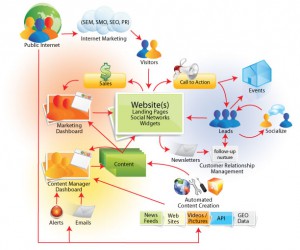There are bloggers, influencers, associations, and even media companies that are launching or hosting ongoing events to serve your audience’s informational needs.
- Rather than just being a participant, some of these events could be strategic content marketing assets that you can purchase and own.
- Most marketers do not have this kind of experience and could use some
 guidance for capitalizing on these opportunities.
guidance for capitalizing on these opportunities.
1: Determine your goal
Like you would for any good business decision, start by determining the reasons why it might possibly make sense to purchase an existing industry event. If you are like Oracle, Salesforce.com, or other large enterprises, you may already have one or two flagship events.
Your business objectives for these events might include:
- To cover a geographic area that your business is currently absent from with an in-person component. The ultimate goal would be to reach more customers for cross-selling, up-selling and decreasing your customer turnover rate in that region.
- To insert your brand into the conversation around a topic you are not well known for. Let’s say you manufacture a certain type of steel and you’ve identified some use in the Oil and Gas industry. It may then make sense to look at smaller Oil and Gas events and immediately become a credible part of the industry lexicon.
- To accomplish lead generation objectives. In addition, the event may come with built-in assets, like a marketing and subscriber list, which can be extremely valuable.
- We are seeing more evidence of marketing departments becoming a profit center. I believe this will be a growing trend, with more and more brands directly profiting from their audiences through sponsorships, subscriptions, etc., as well as through selling more products and services directly to the event attendees.
2: Clearly identify your audience
3: Make your short list of events
Now that you have identified your objective and your audience, start making your list of relevant events that would help you meet your goals. The key is to avoid setting any limitations at this point. If the physical event targets your audience in the general geographic area you are looking at, write it down.
4: Approach the best opportunity
The key at this point is to get discussions started so you can gauge where potential interest may lie. Worst-case scenario when approaching an event that isn’t interested in selling is that you now have the potential to grow a relationship with them from this first contact. Simply put, you never know when intentions might change, and now you have an inside track if they do.
5: Determine the purchase value
6: Make your offer
The brands that are prepared to start looking at their content marketing in an asset-driven way (such as the above) will have a huge advantage over their competition. Start taking the leap.
via http://contentmarketinginstitute.com/2014/05/evaluate-purchase-event-fuel-content-marketing/
Related article
- How to Measure the ROI or Impact of a Press Release in 2014 (businesswire.com)